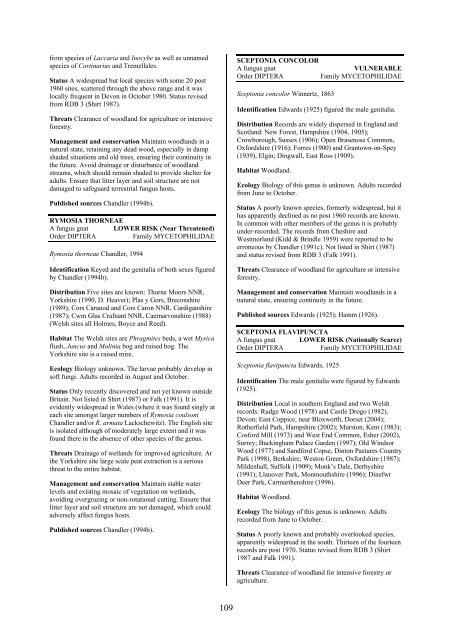Part 2: Nematocera and Aschiza not dealt with by Falk (1991) - JNCC
Part 2: Nematocera and Aschiza not dealt with by Falk (1991) - JNCC
Part 2: Nematocera and Aschiza not dealt with by Falk (1991) - JNCC
You also want an ePaper? Increase the reach of your titles
YUMPU automatically turns print PDFs into web optimized ePapers that Google loves.
from species of Laccaria <strong>and</strong> Inocybe as well as unnamed<br />
species of Cortinarius <strong>and</strong> Tremellales.<br />
Status A widespread but local species <strong>with</strong> some 20 post<br />
1960 sites, scattered through the above range <strong>and</strong> it was<br />
locally frequent in Devon in October 1980. Status revised<br />
from RDB 3 (Shirt 1987).<br />
Threats Clearance of woodl<strong>and</strong> for agriculture or intensive<br />
forestry.<br />
Management <strong>and</strong> conservation Maintain woodl<strong>and</strong>s in a<br />
natural state, retaining any dead wood, especially in damp<br />
shaded situations <strong>and</strong> old trees, ensuring their continuity in<br />
the future. Avoid drainage or disturbance of woodl<strong>and</strong><br />
streams, which should remain shaded to provide shelter for<br />
adults. Ensure that litter layer <strong>and</strong> soil structure are <strong>not</strong><br />
damaged to safeguard terrestrial fungus hosts.<br />
Published sources Ch<strong>and</strong>ler (1994b).<br />
RYMOSIA THORNEAE<br />
A fungus gnat LOWER RISK (Near Threatened)<br />
Order DIPTERA<br />
Family MYCETOPHILIDAE<br />
Rymosia thorneae Ch<strong>and</strong>ler, 1994<br />
Identification Keyed <strong>and</strong> the genitalia of both sexes figured<br />
<strong>by</strong> Ch<strong>and</strong>ler (1994b).<br />
Distribution Five sites are known: Thorne Moors NNR,<br />
Yorkshire (1990, D. Heaver); Plas y Gors, Breconshire<br />
(1989); Cors Caranod <strong>and</strong> Cors Caron NNR, Cardiganshire<br />
(1987); Cwm Glas Crafnant NNR, Caernarvonshire (1988)<br />
(Welsh sites all Holmes, Boyce <strong>and</strong> Reed).<br />
Habitat The Welsh sites are Phragmites beds, a wet Myrica<br />
flush, Juncus <strong>and</strong> Molinia bog <strong>and</strong> raised bog. The<br />
Yorkshire site is a raised mire.<br />
Ecology Biology unknown. The larvae probably develop in<br />
soft fungi. Adults recorded in August <strong>and</strong> October.<br />
Status Only recently discovered <strong>and</strong> <strong>not</strong> yet known outside<br />
Britain. Not listed in Shirt (1987) or <strong>Falk</strong> (<strong>1991</strong>). It is<br />
evidently widespread in Wales (where it was found singly at<br />
each site amongst larger numbers of Rymosia coulsoni<br />
Ch<strong>and</strong>ler <strong>and</strong>/or R. armata Lackschewitz). The English site<br />
is isolated although of moderately large extent <strong>and</strong> it was<br />
found there in the absence of other species of the genus.<br />
Threats Drainage of wetl<strong>and</strong>s for improved agriculture. At<br />
the Yorkshire site large scale peat extraction is a serious<br />
threat to the entire habitat.<br />
Management <strong>and</strong> conservation Maintain stable water<br />
levels <strong>and</strong> existing mosaic of vegetation on wetl<strong>and</strong>s,<br />
avoiding overgrazing or non-rotational cutting. Ensure that<br />
litter layer <strong>and</strong> soil structure are <strong>not</strong> damaged, which could<br />
adversely affect fungus hosts.<br />
Published sources Ch<strong>and</strong>ler (1994b).<br />
SCEPTONIA CONCOLOR<br />
A fungus gnat<br />
VULNERABLE<br />
Order DIPTERA<br />
Family MYCETOPHILIDAE<br />
Sceptonia concolor Winnertz, 1863<br />
Identification Edwards (1925) figured the male genitalia.<br />
Distribution Records are widely dispersed in Engl<strong>and</strong> <strong>and</strong><br />
Scotl<strong>and</strong>: New Forest, Hampshire (1904, 1905);<br />
Crowborough, Sussex (1906); Open Brasenose Common,<br />
Oxfordshire (1916); Forres (1900) <strong>and</strong> Grantown-on-Spey<br />
(1939), Elgin; Dingwall, East Ross (1909).<br />
Habitat Woodl<strong>and</strong>.<br />
Ecology Biology of this genus is unknown. Adults recorded<br />
from June to October.<br />
Status A poorly known species, formerly widespread, but it<br />
has apparently declined as no post 1960 records are known.<br />
In common <strong>with</strong> other members of the genus it is probably<br />
under-recorded. The records from Cheshire <strong>and</strong><br />
Westmorl<strong>and</strong> (Kidd & Brindle 1959) were reported to be<br />
erroneous <strong>by</strong> Ch<strong>and</strong>ler (<strong>1991</strong>c). Not listed in Shirt (1987)<br />
<strong>and</strong> status revised from RDB 3 (<strong>Falk</strong> <strong>1991</strong>).<br />
Threats Clearance of woodl<strong>and</strong> for agriculture or intensive<br />
forestry.<br />
Management <strong>and</strong> conservation Maintain woodl<strong>and</strong>s in a<br />
natural state, ensuring continuity in the future.<br />
Published sources Edwards (1925); Hamm (1926).<br />
SCEPTONIA FLAVIPUNCTA<br />
A fungus gnat LOWER RISK (Nationally Scarce)<br />
Order DIPTERA<br />
Family MYCETOPHILIDAE<br />
Sceptonia flavipuncta Edwards, 1925<br />
Identification The male genitalia were figured <strong>by</strong> Edwards<br />
(1925).<br />
Distribution Local in southern Engl<strong>and</strong> <strong>and</strong> two Welsh<br />
records: Rudge Wood (1978) <strong>and</strong> Castle Drogo (1982),<br />
Devon; East Coppice, near Bloxworth, Dorset (2004);<br />
Rotherfield Park, Hampshire (2002); Murston, Kent (1983);<br />
Cosford Mill (1973) <strong>and</strong> West End Common, Esher (2002),<br />
Surrey; Buckingham Palace Garden (1997); Old Windsor<br />
Wood (1977) <strong>and</strong> S<strong>and</strong>ford Copse, Dinton Pastures Country<br />
Park (1998), Berkshire; Weston Green, Oxfordshire (1987);<br />
Mildenhall, Suffolk (1909); Monk’s Dale, Der<strong>by</strong>shire<br />
(<strong>1991</strong>); Llanover Park, Monmouthshire (1996); Dinefwr<br />
Deer Park, Carmarthenshire (1996).<br />
Habitat Woodl<strong>and</strong>.<br />
Ecology The biology of this genus is unknown. Adults<br />
recorded from June to October.<br />
Status A poorly known <strong>and</strong> probably overlooked species,<br />
apparently widespread in the south. Thirteen of the fourteen<br />
records are post 1970. Status revised from RDB 3 (Shirt<br />
1987 <strong>and</strong> <strong>Falk</strong> <strong>1991</strong>).<br />
Threats Clearance of woodl<strong>and</strong> for intensive forestry or<br />
agriculture.<br />
109
















